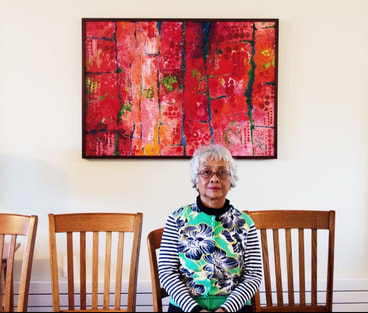About the Artist
|
Timeline
| Lewanda | 1944- Lewanda was born in the jungles of Bukidnon during WWII. Her mother and five siblings hid in the forest because the Japanese Army was pursuing them to take them as hostages for the father, a guerilla lieutenant. The Japanese wanted him to become a puppet mayor of the occupying government. Pedro B. Melendez, was the first native lawyer of Bukidnon who became a delegate to the first constitutional convention in 1935. He later became deputy governor of Mindanao. After the war he was a Regional War Damage Commissioner. The family later settled in Cagayan de Oro where he became "city fiscal" (prosecutor) and a lawyer. Pedro Melendez is a descendant of Datu Mampaalong, the founder of Malabalay that later became the capital of Bukidnon. This information can be viewed in the document, researched by her brother, Pedro R. Melendez, Jr. (Datu Badi). Her mother, Luz Santiago Reyes, was a Tagala from Malolos, Bulacan. She graduated from the University of the Philippines just like her husband. She had a degree in education and taught English for several years before becoming principal of the Misamis Oriental High School. She was named after Lewanda, the mid-wife (“manghihilut”) who delivered her in the jungle. Her middle name, Bertha, was the name of an American missionary and her parents’ matchmaker. Lewanda grew up in Cagayan de Oro City on the island of Mindanao. She attended the local public schools. A shy and introverted child, she loved to explore the rivers, seashore and forest near her home. Her early solitary adventures developed in her a deep connection with nature that still lingers. Her creativity was evident in childhood. She made up games, sewed her own dolls and clothes and learned how to cook and invent recipes. In high school she started to draw and paint but was not really encouraged by her parents. In high school she was editor of the high school newspaper. 1960s-70s In 1961 Lewanda left Mindanao to attend attend college at the University of the Philippines, Diliman. She studied Fine Arts, majoring in art education. After graduating she taught art history and art education at the UP College of Fine Arts . Later, she married Antonio L. Lim, an electrical engineer, then working for General Electric, Philippines. They have two children- Aimee Ingrid and Antonio Jr. both born in the Philippines. The late 60s and early 70s were marked by increasing social unrest and in 1972, martial law was declared by then president, Ferdinand Marcos. Fear, repression and violence were rampant in the whole country. Large numbers of people-mostly opposing the regime, were arrested, detained or killed . Many groups, led by the left , went underground to fight the government. Many professionals left the country because of the political and social climate of the times. In 1975, her husband immigrated to Canada where he found professional work in an electric power component part factory. She and their two children followed him a year later. The family had to adjust to a new climate and cultural milieu . Soon they connected to the Filipino immigrant community which helped them ease the transition and provide emotional support. After three years, her husband was transferred by his company to Pennsylvania, USA. 1980-1990s Forging a new life in another country can be daunting. Like most immigrants, she was resilient and adaptable. They lived in a multi-ethnic community where she found new friends and her children became more westernized and thrived. She enrolled in nearby art courses such as: printmaking and ceramic and honed her dormant painting and drawing skills. She painted a series of watercolor paintings of birds that later ended up in her first one-woman exhibit in the gallery of John Wannamaker in King of Prussia, PA. Being a frugal and resourceful person, she made her own and her children’s clothes as well as quilts. This resulted in an abundant accumulation of fabric scraps that will inspire her to create her first fabric collages. Her family moved to several locations in the Northeast and Mid-Western part of the United States, each time appreciating the varied landscapes and educational opportunities. When they lived in Upstate New York, she went to graduate school after her children left for college. She attended SUNY Albany and obtained her Master’s in Studio Art. While at SUNY Albany her work focused on environmental issues. Later she would shift her attention to Filipino-American history and issues pertinent to immigrants’ experiences. Her trips back to the Philippines inspired a whole collection of paintings describing her favorite haunts- the wet markets or “palengke”. Working from photographs she took of the markets, she painted realistic interpretations of daily life in the palengke. She devised a method of collage making using the sewing machine. First she composed aesthetically pleasing assemblages of fabric and yarn that she pieced together through multitude of stitches. This resulted in a very unique and original material from which she fashioned one-of-a-kind vests and free standing art works. 2000- current Lewanda’s fabric collage work continues to grow and expand in size and content. She started creating larger, more dramatic and thought-provoking pieces. Fueled by her love of the natural world and concerns for the environment she continues to work on a series of large scale collages. Her visual narrative of Philippine Colonial history, Filipino-American experiences and the global diaspora remains as an on-going project. She is also experimenting with new printmaking techniques and planning on a series for future exhibits. Now in her 70s, she maintains a lively, creative life, exploring new technical possibilities with varying materials and subject matters. Lewanda currently lives and creates in West Medford, MA with her husband, his vegetable gardens and her beloved flower beds. Follow her on Instagram and website here. |
